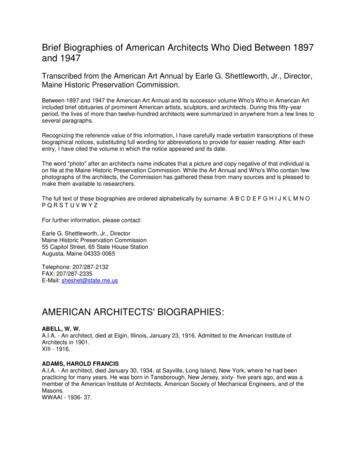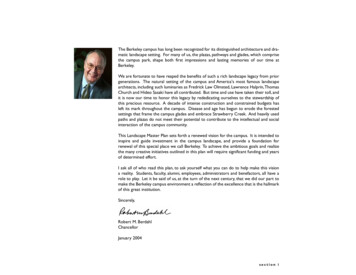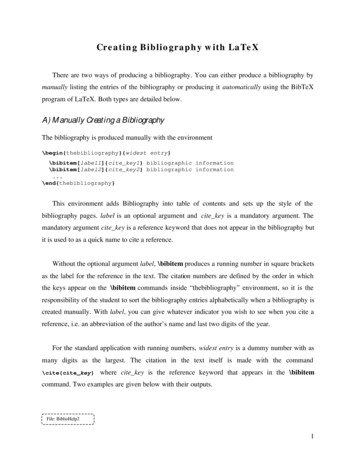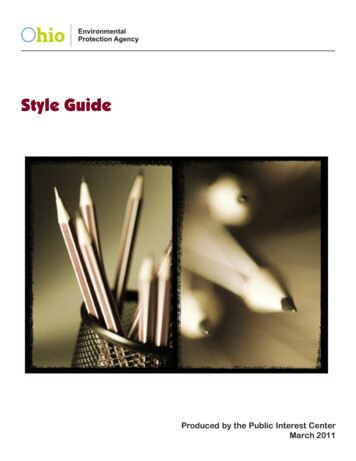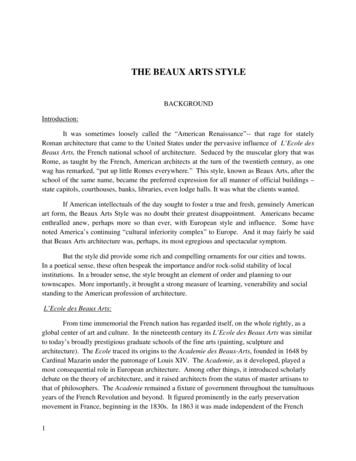
Transcription
THE BEAUX ARTS STYLEBACKGROUNDIntroduction:It was sometimes loosely called the “American Renaissance”-- that rage for statelyRoman architecture that came to the United States under the pervasive influence of L’Ecole desBeaux Arts, the French national school of architecture. Seduced by the muscular glory that wasRome, as taught by the French, American architects at the turn of the twentieth century, as onewag has remarked, “put up little Romes everywhere.” This style, known as Beaux Arts, after theschool of the same name, became the preferred expression for all manner of official buildings –state capitols, courthouses, banks, libraries, even lodge halls. It was what the clients wanted.If American intellectuals of the day sought to foster a true and fresh, genuinely Americanart form, the Beaux Arts Style was no doubt their greatest disappointment. Americans becameenthralled anew, perhaps more so than ever, with European style and influence. Some havenoted America’s continuing “cultural inferiority complex” to Europe. And it may fairly be saidthat Beaux Arts architecture was, perhaps, its most egregious and spectacular symptom.But the style did provide some rich and compelling ornaments for our cities and towns.In a poetical sense, these often bespeak the importance and/or rock-solid stability of localinstitutions. In a broader sense, the style brought an element of order and planning to ourtownscapes. More importantly, it brought a strong measure of learning, venerability and socialstanding to the American profession of architecture.L’Ecole des Beaux Arts:From time immemorial the French nation has regarded itself, on the whole rightly, as aglobal center of art and culture. In the nineteenth century its L’Ecole des Beaux Arts was similarto today’s broadly prestigious graduate schools of the fine arts (painting, sculpture andarchitecture). The Ecole traced its origins to the Academie des Beaux-Arts, founded in 1648 byCardinal Mazarin under the patronage of Louis XIV. The Academie, as it developed, played amost consequential role in European architecture. Among other things, it introduced scholarlydebate on the theory of architecture, and it raised architects from the status of master artisans tothat of philosophers. The Academie remained a fixture of government throughout the tumultuousyears of the French Revolution and beyond. It figured prominently in the early preservationmovement in France, beginning in the 1830s. In 1863 it was made independent of the French1
government by order of Emperor Napoleon III, wherein it was rechristened L’Ecole des BeauxArts.As a school, it attracted students from many countries, most notably, the United States.The Ecole trained young architects to have an indepth understanding of architectural history andto be able to design in “the manner of” (i.e., in the manner of great architects and styles of thepast). Indeed, quotation from well-known landmarks of antiquity was considered a sign ofcultivation rather than poverty of invention or originality. Although hundreds upon hundredstook the five-part entrance exam (which was a mark of the Ecole’s prestige), the school onlyadmitted sixty students per term, 45 French and 15 foreign. Students received broad instructionin painting, sculpture, history, geometry, philosophy and mathematics. Student training at theEcole was uncommonly rigorous. Students were driven with punishing workloads. Projectsroutinely required dozens of highly detailed architectural drawings accurately produced in a shorttime – these, then, to be roundly critiqued by elevated faculty or atelier (studio) masters. It couldbe a humbling experience for many a young man.Skills were honed at creating architectural renderings that would amaze – rich and heavywith detail, plenty to look at in them, and in color, watercolor being, then as now, a most difficultmedium. And there were fiercely selective design competitions, the greatest being the Prix deRome (Prize of Rome), which provided a scholarship to the honored one to study in Rome, thenregarded as the fountainhead of classicism. It was that robust, manifestly imperial classicismthat the Ecole saw as one of the great and eternal truths of architecture.The Ecole Approach Comes to America:As late as the final third of the nineteenth century, being a professional architect, or forthat matter an attorney, did not require a university education. Indeed, as one observer put it,architects were “simply carpenters putting on airs.” There were no architects, as we understandthe term, in early America. Such designing of buildings as took place was either carried out by1) gifted builders or carpenters with access to European (generally British) published styleguides and pattern books, or 2) gentlemen amateurs who cultivated their exquisite taste, studiedthe classics, and designed homes for themselves, their friends and social equals. It was a finehobby for a gentleman but one for which he did not expect to be paid. Thomas Jefferson is thegreatest, but by no means the only, example.London trained Benjamin Henry Latrobe (1764 – 1820) is generally regarded asAmerica’s first professional architect. He trained others as he was trained, throughapprenticeship. A young man might start as a floor sweeper or general doer of menial tasks,watch, learn to draw the classical orders, be promoted to junior draftsman, hone his skills, makesenior draftsman grade, and finally take his place alongside the “great man” as a junior partner inthe architectural practice. The finished architects who emerged through this system wereessentially job trained businessmen with no higher aspirations. Late in his life, architect George2
B. Post wrote somewhat bitterly of architecture as a profession during his mid-nineteenth centuryyouth: “The American painters and sculptors were frankly outspoken in their opinion that therewas no art in architecture.”All this began to change in the decades after the Civil War. Under the influence of thenewly founded American Institute of Architects (1857), a handful of established universitiesbegan formal academic training programs in architecture. A pivotal event was the founding, in1893, of the Society of Beaux Arts Architects by mainly American alumni of the famed Ecole.What they established and nurtured was essentially a shadow Ecole des Beaux Arts in the UnitedStates. It was really a collection of mini-academies, some connected with university degreeprograms in architecture such as MIT and Columbia, others run independently by studioprofessors or architectural clubs.All sought to standardize the Ecole des Beaux Arts style atelier (studio) teaching systemfor budding young American architects. They stressed classical proportions, scale, balance,beauty, and a deep understanding of architecture from the ancient world down through theRenaissance. They also shone as centers of lively discussion on all matters of aesthetics, and in awider sense, civilization. Flush with funding from august figures such as J. Pierpont Morgan andAndrew Carnegie, the Society of Beaux Arts Architects was able to sponsor Ecole style designcompetitions with cash prizes – the greatest being the Paris Prize -- funding to study in France atthe Ecole itself. It was the American answer to the Prix de Rome.As more and more universities began to offer degrees in architecture, most opted for theEcole des Beaux Arts system as central to training young American architects. This dominancewould not be seriously challenged until the tide of European Modernism swept ashore beginningin the 1930s.The 1893 Columbian Exposition:To the eye of the cultured young architect, or the mature professional, Americandowntowns of the late nineteenth century could seem a chaotic unplanned agglomeration ofbuildings of different sizes and periods, railroads here and there, great brick walls painted withsigns advertising parent medicines -- all in all, boisterous, sentimental and messy. Then camethe Chicago World’s Fair of 1893, also known as the Columbian Exhibition (to celebrate the400th anniversary of Christopher Columbus’ epic voyage). One of the fair’s architects, CharlesFollen McKim, summed it up in a statement that could have been the fair’s motto, “The scale isRoman, and it will have to be sustained.” Also dubbed the “White City,” the Chicago fair was aconvincing show of power for the rising tide of Beaux Arts influence in the United States. Itfeatured monumental and imposing Roman style classical buildings, in white plaster, set in a vastand verdant landscape of parks, lagoons and grand avenues (Photo 1).Those who attended the fair would remember it for the rest of their lives as a sight tobehold. It also cast something of a spell over the country as major cities tried to remake their3
downtowns in the fair’s image, with classical buildings, grand vistas, Parisian style boulevards,etc. All this is remembered today as the City Beautiful Movement. It is discussed only brieflyhere because it had little impact in Louisiana.Character-Defining Features:The Beaux Arts is a classical style with the full range of Greco-Roman elements: thecolumn, arch, vault and dome. It is the showy, almost operatic, manner in which these elementsare composed that gives the style its characteristic flavor. General character-defining elementsinclude: Symmetrical articulationLavish and intensive surface decorationA single architectural element set as a grand gesture – often an over-scaledarchway, triple archway or short but dramatic colonnade as the center of thecompositionCoupled columnsFacades composed around advancing and receding wall planes. The transitionfrom one plane to another is often highlighted with multiple corner elements.Entablatures that advance and recede to mark the locations of columns belowAn active roofline (for a classical style) with dramatic roof-top figure sculptureFully and boldly formed ornamental sculpture employed elsewhere on the facades(as opposed to more subtle bas relief)Monumental (sometimes multiple) runs of steps approaching a building’sentranceFloor plans that culminate in a single grand roomAxial floor plans that establish vistas through different spacesBuilding Materials:Beaux Arts buildings were designed to make a formal statement. Thus their materialstend to be of the best and most expensive quality. In most the predominant material is lightcolored stone, often limestone, and often richly worked with strong bas relief, rooftop sculpturalelements, quoins and rustication. Rock-face stone is virtually never used. Sometimes stone isused in combination with light-colored brick (to save money). Sometimes the material is caststone or, in lesser examples, cast concrete. For lamp standards, fittings and details, glazed terracotta is sometimes used as well a wrought iron-looking material.Materials of note on interiors include marble (often colorful and richly veined), polishedwoods (usually dark), alabaster, terrazzo floors, polished brass and bronze (for ornament and4
fittings), and, on fine examples, gold leaf. Interiors may also feature painterly effects, fresco(looking) murals and the like.Beaux Arts Urban Planning:The Beaux Arts approach to design had a strong urban planning component. In this itwas solidly in the tradition of a style of town planning that emerged during the sixteenth andseventeenth centuries in Europe. It is still known to this day as Baroque city planning. It relieson grand, tree-lined avenues; axial cross streets; and long vistas terminating at carefully placedclassical façades. A central feature is the so-called “crow’s foot” -- three or more avenuesstarting at a single central point (on a grand public square) and fanning out in different directionsto give dynamic vistas through a city. City plans of this type were sometimes created in theUnited States, L’Enfant’s plan for Washington D. C. for instance. In palace gardens it took theform of immaculately clipped hedge parterres setting off avenues and vistas – nature made tolook rather unnatural – sometimes called the French Garden. This is in contrast to thenaturalistic English Garden tradition.THE LOUISIANA STORYIn Louisiana local architects took up the Beaux Arts style as did their counterparts inother states. They were mostly based in New Orleans (historically the state’s largest city), with afew in Shreveport (historically the second largest city). While the state has only a modestnumber of examples, the buildings by their very nature make major architectural statements.Hence their impact upon our city and townscapes is greater than numbers alone would indicate.In some Louisiana communities, the single Beaux Arts style building that might exist is clearlythe landmark of the town, providing an anchor – a sense of place.Beaux Arts-inspired city planning, French as it was, made virtually no impact inLouisiana. The only significant exceptions would be Theodore C. Link’s original (1922) plan forthe Louisiana State University campus in Baton Rouge (since altered) and Barksdale Air ForceBase, Bossier City (1931). (For the latter, see Photo 2.)Property Types:In Louisiana almost all extant Beaux Arts style buildings are of the following propertytypes: courthouses (photos 3 & 4) banks (photos 5-8) fraternal organization halls (photos 9 & 10)5
librariesDate Range:The Beaux Arts Style is seen in Louisiana from about 1895 to about 1915.Geographical Range:As a general rule Beaux Arts is, first and foremost, an urban style. In the northeasternUnited States one does see exceptions, such as Beaux Arts country retreats or great houses on anestate (the Vanderbilt Estate in Hyde Park, New York comes to mind). But in Louisiana thestyle is confined to established towns and cities. One searches in vain for a Beaux Artsplantation house. The range is therefore statewide, but limited to areas that were relatively welldeveloped during the heyday of the style’s popularity.National Register Guidance:Local Significance: Beaux Arts buildings were designed to impress. Thus any survivingexample will likely be one of the (if not the) most distinguished historic buildings in a givencommunity. In all likelihood, it will be easily among the most impressively and elaboratelystyled works of architecture and hence stand as at least a local landmark. This general argumentfor National Register eligibility can be expected to hold good in the vast majority ofcommunities in the state.Exceptions might be larger and old cities in which there is a great deal of competition forlocal architectural significance. Even then, a building in the Beaux Arts genre may besufficiently different from the city’s other important buildings that it could qualify for theRegister as something stylistically distinctive. In short, even the largest and oldest Louisianacities have few Beaux Arts buildings. In such instances, one could make the dual case that (1)the building was one of few examples of this popular national style in a given place, and (2) thatit was a particularly good example of the style – i.e., because it had many character-definingfeatures of the style.State Significance: Establishing state significance for Beaux Arts buildings can be achallenge. Looking across a state’s patrimony, one might confront a roster of roughlycomparable examples. Superior standing for one particular example may rest upon 1)comparatively enormous size and/or monumentality (although this alone does not equalarchitectural significance); 2) pristine integrity (see below); 3) an exceptionally fine interior;and/or 4) particularly notable artistic embellishments (statuary, etc.). Generally speaking, theBeaux Arts buildings in Louisiana that might have a case for state significance are in the largercities.6
National Significance: The authors, based on over 60 years field experience in Louisiana,cannot imagine a Beaux Arts building in the state that would meet the high threshold of nationalsignificance.A major consideration confronting any National Register candidate is architecturalintegrity. This is typically not a issue for Beaux Arts buildings. They were constructed ofmaterials meant to last (stone, terra-cotta, etc.) and are not as subject to rapid decay and featurereplacement as are wooden buildings. (Decay aside, it’s harder to knock off or cover Beaux Artsfeatures by definition.)The kind of alterations Beaux Arts buildings might receive typically would be badwindow replacement or subdivided interiors – neither of which are generally severe enough tomake a building ineligible due to loss of integrity. In the aforementioned scenario, the survivingoriginal exterior features (grand columns, arches, etc) are generally of sufficient architecturalprominence to “carry the day” so-to-speak. In other words, the strong Beaux Arts charactervisually dominates the window replacements.Bibliography:Fricker, Jonathan; Fricker, Donna; Duncan, Patricia. Louisiana Architecture: AHandbook on Styles. Lafayette, Louisiana: Center for Louisiana Studies,University of Southwestern Louisiana, 1998.Harmon, Robert B. Beaux Arts Classicism in American Architecture: A Brief StyleGuide. Vance Bibliographies, 1983.Poesch, Jessie and Bacot, Barbara SoRelle, editors. Louisiana Buildings, 1710-1940.Baton Rouge, Louisiana: Louisiana State University Press, 1993.Brooklyn Museum. The American Renaissance, 1876-1917. New York: PantheonBooks, 1979.This document was prepared for the Louisiana Division of Historic Preservation by:Jonathan and Donna FrickerFricker Historic Preservation Services, LLCFirst Draft: September 2009Final Draft: February 20107
PHOTO GALLERYPhoto Exposition,1. Columbian o 2. Beaux Arts planning at BarksdaleAir Force Base, 1931, Bossier City,Louisiana. Courtesy LSU-ShreveportArchives.8
Photo 3. The Louisiana Supreme Court building (19081910), in New Orleans, is easily the state’s largest BeauxArts building. Note the advancing and receding wallplanes, the colossal coupled pilasters, and the greatround arch openings marking the entrance.Photo 4. The DeSoto Parish Courthouse in Mansfield, one of severalBeaux Arts style courthouses in the state. (1911, Favrot and Livaudais,architects, New Orleans)9
Photos 5-6. Beaux Arts banks in Opelousas (above) and Donaldsonville (below).10
Photo 7. The richly detailed Ruston State Bank(1910), complete with a central Roman triumphalarch.Photo 8. This bank in the small town of Hessmer is a fairly restrained example of the BeauxArts taste.11
Photo 9. Scottish Rite Cathedral, Shreveport, Louisiana’s mostflamboyant surviving Beaux Arts building (1915, Edward F. Neild,architect, Shreveport). Courtesy LSU-Shreveport Archives.Photo 10. B’Nai Zion Temple, Shreveport. 1915, Edward F. Neild & ClarenceOlschner, architects, Shreveport.12
All sought to standardize the Ecole des Beaux Arts style atelier (studio) teaching system for budding young American architects. They stressed classical proportions, scale, balance, beauty, and a deep understanding of architec


